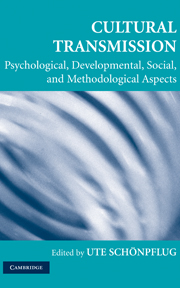Book contents
- Frontmatter
- Contents
- Foreword
- Contributors
- 1 Introduction to Cultural Transmission: Psychological, Developmental, Social, and Methodological Aspects
- 2 Theory and Research in Cultural Transmission: A Short History
- PART ONE EVOLUTIONARY PERSPECTIVE
- PART TWO CROSS-CULTURAL PERSPECTIVE
- 6 An Ecocultural Perspective on Cultural Transmission: The Family across Cultures
- 7 Intergenerational Relations and Cultural Transmission
- 8 Intergenerational Transmission, Social Capital, and Interethnic Contact in Immigrant Families
- 9 Developmental Processes Related to Intergenerational Transmission of Culture: Growing Up with Two Cultures
- 10 The Transmission Process: Mechanisms and Contexts
- 11 Accounting for Parent–Child Value Congruence: Theoretical Considerations and Empirical Evidence
- 12 Culture, Migration, and Family-Value Socialization: A Theoretical Model and Empirical Investigation with Russian-Immigrant Youth in Israel
- 13 Immigrant Parents' Age Expectations for the Development of Their Adolescent Offspring: Transmission Effects and Changes after Immigration
- PART THREE INTRACULTURAL VARIATIONS
- Index
- References
10 - The Transmission Process: Mechanisms and Contexts
Published online by Cambridge University Press: 05 June 2012
- Frontmatter
- Contents
- Foreword
- Contributors
- 1 Introduction to Cultural Transmission: Psychological, Developmental, Social, and Methodological Aspects
- 2 Theory and Research in Cultural Transmission: A Short History
- PART ONE EVOLUTIONARY PERSPECTIVE
- PART TWO CROSS-CULTURAL PERSPECTIVE
- 6 An Ecocultural Perspective on Cultural Transmission: The Family across Cultures
- 7 Intergenerational Relations and Cultural Transmission
- 8 Intergenerational Transmission, Social Capital, and Interethnic Contact in Immigrant Families
- 9 Developmental Processes Related to Intergenerational Transmission of Culture: Growing Up with Two Cultures
- 10 The Transmission Process: Mechanisms and Contexts
- 11 Accounting for Parent–Child Value Congruence: Theoretical Considerations and Empirical Evidence
- 12 Culture, Migration, and Family-Value Socialization: A Theoretical Model and Empirical Investigation with Russian-Immigrant Youth in Israel
- 13 Immigrant Parents' Age Expectations for the Development of Their Adolescent Offspring: Transmission Effects and Changes after Immigration
- PART THREE INTRACULTURAL VARIATIONS
- Index
- References
Summary
INTRODUCTION
Cultural transmission – as opposed to genetic transmission – requires some form of social learning. Thus, no one would claim cultural transmission if all members of a population learned a particular behavior only because they had all been exposed to the same set of contingencies from the physical environment. In this case, there is no cultural transmission because there is no social learning. Intergenerational cultural transmission is clearly the appropriate concept, on the other hand, when adults intentionally teach the younger generation or when the younger generation imitates adults. Such clear forms of transmission may not always be involved in the intergenerational transfer of information, however. The term cultural in cultural transmission indicates the transmission of cultural elements that are widely distributed, such as social orientations, knowledge, skills, and behaviors (e.g., rituals).
Cultural persistence is essentially a question of social transmission (Cavalli-Sforza & Feldman, 1981). Vertical social transmission from the parent generation to the offspring generation may prepare the ground for continuity in culture. It is less responsive to environmental variability (Laland, 1993). However, the process of cultural transmission does not lead to a constant replication of culture in successive generations; rather, it falls somewhere between an exact transmission (with hardly any difference between parents and offspring) and a complete failure of transmission (with hardly any similarity between the generations).
- Type
- Chapter
- Information
- Cultural TransmissionPsychological, Developmental, Social, and Methodological Aspects, pp. 212 - 239Publisher: Cambridge University PressPrint publication year: 2008
References
- 7
- Cited by



